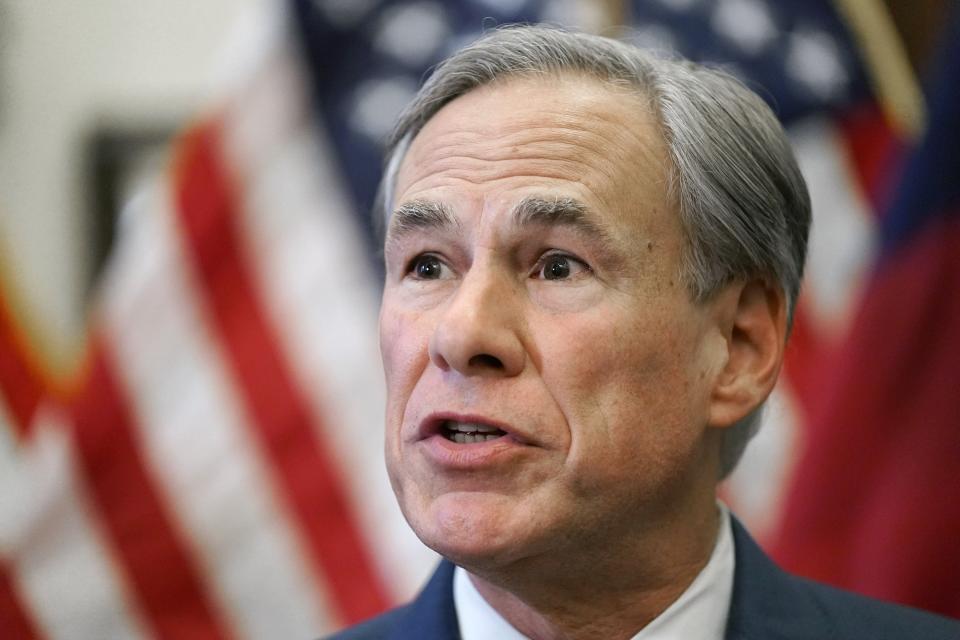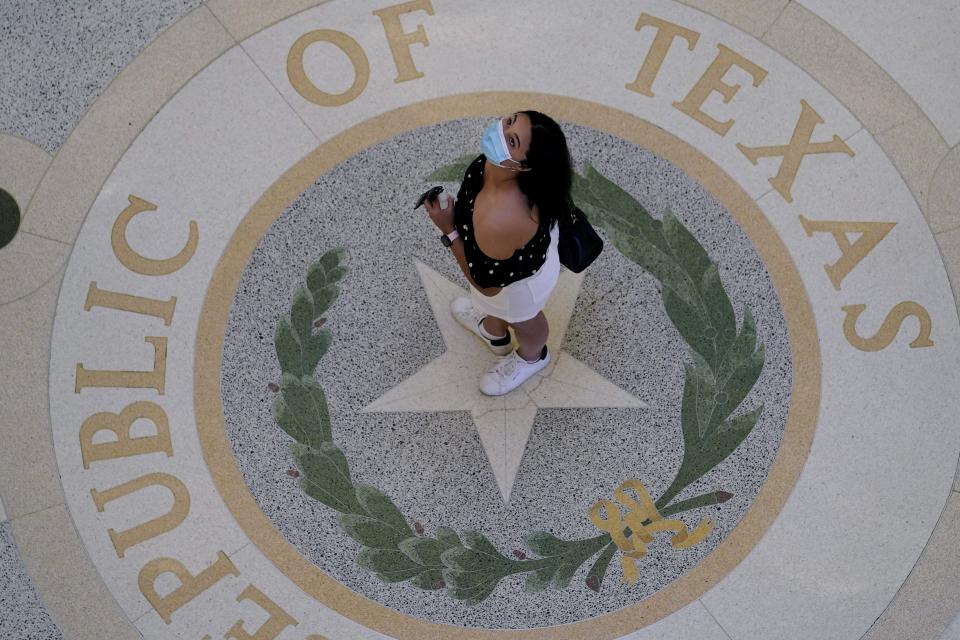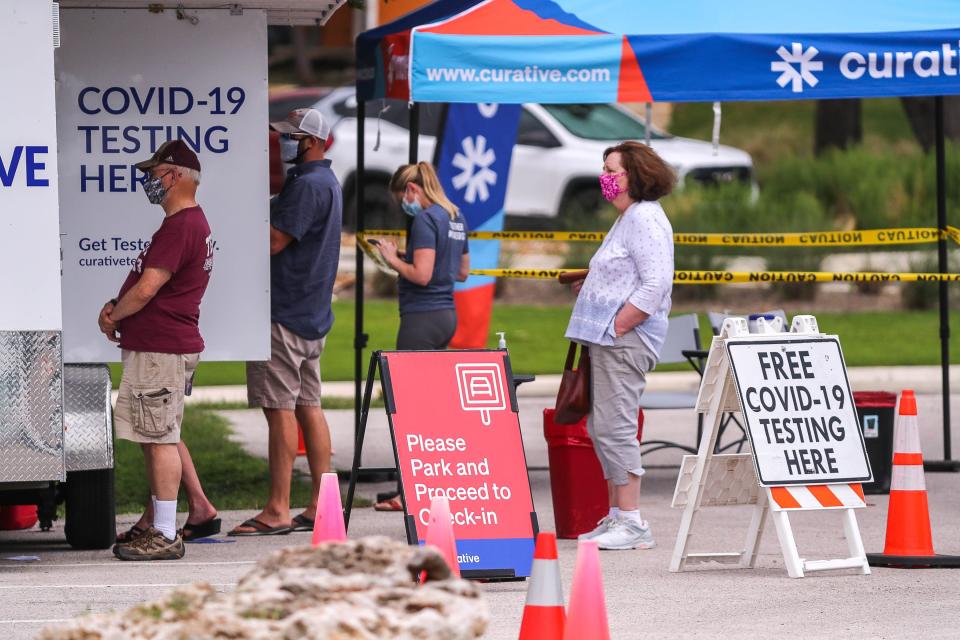Texas rejected pleas for additional nurses, assistance. Then the COVID-19 surge hit.
- Oops!Something went wrong.Please try again later.
When health officials in Austin and elsewhere in Texas saw an approaching COVID-19 surge last month, they sent urgent requests to the governor's emergency operations team to bolster the number of nurses and staff.
They had every reason to believe that more health care workers would soon fill hospital hallways.
But as the sick inundated COVID-19 wards and ICU beds, the state rejected those requests.
It wasn’t until Wednesday — after Texas became a national COVID-19 epicenter and the most patients since February overwhelmed hospitals — that Gov. Greg Abbott announced that the state would bring in 2,500 nurses from across the U.S. and pay them until Sept. 30.
More: Texas now has the fewest ICU beds available it's had during the entire COVID-19 pandemic

The state’s policies about whether to help supply nurses have flip-flopped in recent weeks. Along with the sheer number of cases, the staffing shortage has fueled what Austin officials declared a “dire” situation that also has prevented them from diverting patients to a makeshift hospital at the Austin Convention Center, as they had done previously.
At the height of the pandemic, up to 14,000 employees responded to Texas hospitals through staffing contracts overseen by the Texas Department of State Health Services at a cost of $5.3 billion. Hospital administrators say the extra workers shored up critical staffing levels and undoubtedly saved lives.
The Abbott administration, however, changed its position on supplying workers when the latest coronavirus surge from the delta variant struck last month. Instead of offering a nurse pipeline, the Texas Division of Emergency Management directed local governments and providers, including those in badly infected Austin, to enter a highly competitive market for hospital staff with billions of untapped federal dollars.
“The substantial funding is available to support urgent COVID-19 response efforts to decrease the spread of the virus, including enhanced staffing expenses at hospitals and premium pay for essential workers,” wrote Nim Kidd, chief of the Texas Division of Emergency Management, in a July 29 letter to county and city leaders statewide. "If you have trouble accessing these funds to arrange and pay for medical staff and hospitalization costs, please let us know."

State Sen. Sarah Eckhardt, D-Austin, said local officials had recently asked her to help lobby the state to return to helping coordinate the supply of nurses, particularly during the surge.
“I have seen the state really dismantle what it built reluctantly in the first two surges, rather than improve on the model,” Eckhardt said. “There is a dearth of nursing capacity for what we are seeing, and we are really feeling the effects of that now.”
The last mask mandate: What was Texas' hospitalization rate, ICU bed availability when Gov. Greg Abbott ordered a mask mandate?
The region that includes Austin-Travis County and 10 other counties — with 2.3 million residents — dwindled to only two available staffed ICU beds Tuesday, the lowest number since the summer surge started. Statewide, the number of available beds dropped to a new pandemic low, with 329 staffed ICU beds available for an estimated 30 million people. The state also saw an average of more than 10,000 new cases per day for the past week.
Hospital executives say the latest surge is compounded not only by issues over who pays for nurses, but increasing difficulty recruiting them.
Those making lower wages in one facility can be easily lured away by higher-paying temporary agencies, creating a domino effect statewide by filling a void in one place but creating another elsewhere.
In a Texas Senate committee meeting Tuesday, hospital executives said that finding nurses also has been especially difficult with many leaving the profession because of the pandemic’s toll.
Nurses now on the way to help Texas fight COVID-19
Department of State Health Services spokesperson Chris Van Deusen confirmed that officials in a large region that includes Austin, Waco and Bryan-College Station have submitted 34 requests for 700 addition health care personnel since July 12.
None had been filled as of Wednesday, he said. But by Thursday, about 300 had been allotted for that region.
In a February pandemic peak, the state had about 900 supplemental employees working in the same area, Van Deusen said. It was not clear how many of those requests were specifically in Austin.
In a joint statement, operators of Austin’s three major health care networks said they continue to struggle with a shortage of nurses and have turned to multiple resources and have increased shifts and are paying bonuses. The health care networks said they “welcome the additional medical personnel who may soon become available through the state.”
Last week, Abbott began rekindling staffing plans that had been in place earlier in the pandemic. Kidd, the emergency management chief, told the state Senate Health and Human Services Committee that nurses could begin arriving at some hospitals “in three to five days.”
"The governor made it very clear to me that the intent is to go out there and help the health system and get it shored back up,” he said. “Yes, we will get it plugged back in.”
Abbott also asked hospitals to again delay nonemergency surgeries to free up staffing and space for COVID-19 patients, as he had done last year. And he directed officials to open more COVID-19 antibody infusion centers that treat patients with therapeutic drugs and said the state would rely on staffing agencies for that.
Abbott also has continued to stress the need for personal responsibility in fighting the surge and has rejected calls for mask mandates.
'STAR' requests made to fight surge in COVID-19 cases, hospitalizations
Abbott’s program to supply nurses through the end of next month will operate similarly to how it previously did. In 2020, hospital operators and others relied upon what officials call a “state of Texas assistance request” to help local officials respond to emergencies and disasters.
The Texas Division of Emergency Management routes such requests — initially for masks and other personal protective equipment last spring — to the appropriate state agency or to the federal government if state resources are depleted.
As more patients faced hospital admissions in the most recent surge, requests began focusing on staff, especially nurses.
More: Texas COVID-19 hospitalizations rising faster than any time during pandemic, health officials say
Van Deusen said the state maintained contracts with staffing agencies and turned to them for thousands of hospital workers. But once the state received $10.5 billion through the Coronavirus State and Local Fiscal Recovery Funds, and the number of hospitalizations decreased because of vaccinations, Texas began cutting back on contracted workers and temporary employees.
"We didn't want to yank the rug out from anyone, of course, so it was over a few months that we drew that staffing down," Van Deusen said.
The state emergency management division said of the $10.5 billion, $5.7 billion went directly to the state's 254 counties and $3.4 billion went to more than 75 Texas cities.

In the Senate committee hearing, Kidd said many cities and counties have not tried to tap into the federal funds. He asked senators to help make local officials aware of the money.
"This is frustrating for those of us who are trying to help and trying to provide services and resources," he said.
But hospital executives testified that although they may have the money, they still struggle to find nurses to urgently fill those slots.
Dr. Esmaeil Porsa, CEO of Harris Health System in Houston, said he has offered bonuses for nurses treating COVID-19 patients and other financial incentives, such as retention and sign-on bonuses.
“All those things are happening,” Porsa said.
Health care executives told the committee about instances in which nurses left in the middle of shifts because they received higher-paying temporary offers.
“It is like a bidding war,” said Dr. Joe Chang, chief medical officer for Parkland Health & Hospital System in Dallas. “We are finding it basically impossible to recruit and staff.”
In a news release Wednesday, the Texas Department of State Health Services said it had directed staffing agencies not to pluck nurses from hospitals in the state but to instead seek them from lesser-hit parts of the country.
More: How can Texas stop the COVID-19 delta surge? We asked an infectious disease expert
The state health department said in a news release that facilities should continue to funnel their requests through the emergency management division and “be judicious.”
The release concluded that the agency “has funds available to support immediate staffing costs. However, extended staff deployments may require cost sharing by local governments or individual facilities.”
This article originally appeared on Austin American-Statesman: Texas declined to help hospitals as officials saw COVID surge coming

